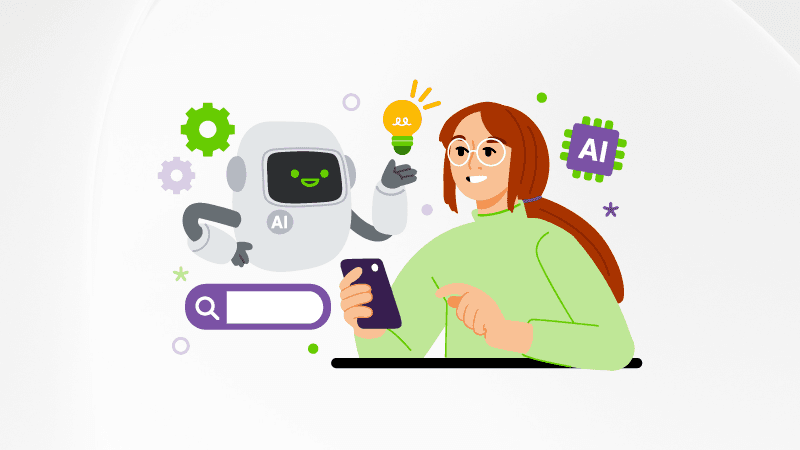Agentic AI and automation in action — real-life success stories

You’ve likely heard the promises before: “Automation will transform your business.” “AI will do the heavy lifting.” “Work smarter, not harder with automation.”
We're even guilty of using that last one. But these promises aren’t empty!
According to Zendesk benchmark data, two thirds of business leaders report that investment in customer service AI leads to significant performance improvements — and support agents who use AI copilots are 20% more likely to feel empowered in their roles.
The potential is real, but for many organizations, realizing that value is still a work in progress.
That’s likely because the applications of AI are evolving at breakneck speed. Since generative AI’s breakout moment in 2022, some businesses are still wrestling with how to implement it effectively. And just as they start to find their footing, the next wave is already here.
We’re no longer just talking about faster scripts or smarter chatbots. We’re entering the era of agentic AI: systems that don’t just follow rules, they interpret context, make decisions and act independently.

Are you ready for the era of agentic AI?
Join Steve Nemzer, director of AI growth and innovation for TELUS Digital, as he unveils the transformative world of agentic artificial intelligence (AI). Learn what makes AI “agentic”, various use cases and implementation best practices to benefit your organization.
To make sense of this shift, it helps to view AI as a maturity curve, rather than a binary choice. At one end, you’ve got rule-based systems that follow instructions. At the other are autonomous agents capable of managing complex workflows with minimal oversight.
Ultimately, there are three levels of AI maturity: assisted, augmented and autonomous intelligence.
Here’s a simple analogy to bring this to life:
- Assisted intelligence is like riding a horse. The horse provides power and speed, but you’re guiding it entirely. In practice, the human decides and the machine does — executing predefined tasks such as data entry or order processing.
- Augmented intelligence is like driving a car with advanced assistance features. You’re still in control, but the system suggests route changes, alerts you to hazards and adjusts your speed. This reflects a model where humans and machines decide together. The AI proposes options or predictions based on data, but the human chooses whether to act on them.
- Autonomous intelligence, or agentic AI, is like a self-driving car. The system plans the route, adapts to conditions and gets you there while you monitor from the passenger seat. At this level, the machine is capable of making decisions and taking action on its own, with the human shifting into a supervisory role who intervenes only when needed.
These stages help illustrate where your organization might be today and where it could go next. But the most compelling insights come from seeing these concepts in action.
In the sections that follow, we’ll look at real-world examples of how TELUS Digital clients are using AI to solve complex challenges, streamline operations and deliver measurable outcomes — at every stage of the maturity curve.
Assisted intelligence in action: Order automation at scale
For many organizations, the first step toward AI maturity starts with assisted intelligence, where machines execute tasks but all decisions still come from humans. These systems follow predefined rules, offering speed and consistency without the complexity of learning or adapting.
This is the domain of Robotic Process Automation (RPA): software that mimics human actions to complete repetitive, structured tasks. RPA doesn’t think or reason, but it excels at following instructions with precision. It’s often used to streamline workflows like data entry, order processing or information transfers between systems. This is what we previously referred to as the horse stage of AI maturity: powerful, reliable and fully directed by a human rider.
That was the case for a global frozen food manufacturer working with TELUS Digital. Its teams were manually handling order appointment data across a complex vendor network. This was an inefficient, error-prone process that introduced delays and strained partner relationships.
With the introduction of an RPA-based automation solution, the company saw significant improvements, including:
- Order processing time was reduced by 3.5 times;
- More than 90,000 orders were automated across multiple vendor systems, resulting in an estimated $500,000 in annual savings; and
- Vendor appointments were faster and more accurate, leading to improved satisfaction and smoother collaboration.
In this example, there was no AI prediction or autonomous decision-making involved, just precise automation applied to a clearly defined task. But the impact was anything but basic.
Assisted intelligence solutions like these often serve as the foundation for more advanced initiatives. They build internal confidence, establish baseline efficiencies and create space for organizations to start exploring how AI might take them further.
Augmented intelligence in action: Smarter fraud detection
As organizations evolve their automation strategies, many find themselves entering the realm of augmented intelligence. Unlike rule-based systems, augmented intelligence blends human expertise with AI-driven insights. The machine supports decision-making by identifying patterns, surfacing recommendations and learning from outcomes, while humans remain actively involved in interpreting the information and taking action.
It’s a collaborative model. AI doesn’t replace human judgment, it enhances it. The human is still in control, but with added visibility, guidance and real-time support, the experience becomes more efficient and responsive.
This is where a major financial institution found itself when it partnered with TELUS Digital to tackle a rising fraud challenge. Customers were waiting up to 20 minutes for transaction verifications, and inconsistent security protocols across channels were creating gaps that fraudsters could exploit. At the same time, false positives were increasing, placing unnecessary strain on the contact center and frustrating legitimate customers.
Our team helped deploy an AI-powered fraud detection and prevention system designed to strike the right balance between speed, accuracy and customer trust. The system introduced instant verification, predictive modeling and proactive alerts, with human agents stepping in for complex cases or policy refinements.
The results were notable:
- Fraud detection accuracy improved by 45%;
- False positives decreased by 80%;
- 50% drop in fraud-related call volume to their contact center;
- 60% improvement in average handle time;
- 35% increase in customer satisfaction; and
- Retention among high-value segments rose by 15%.
This wasn’t a fully autonomous system, nor did it need to be. It was smart enough to support faster, more consistent decisions, while still giving humans the oversight and context they needed to do their job more accurately. Analysts could focus on complex investigations and policy development instead of chasing down routine cases.
Augmented intelligence offers a compelling middle ground. It pairs machine efficiency with human intuition, delivering stronger outcomes without losing transparency or control.
Autonomous intelligence in action: AI agents in healthcare
At the most advanced stage of the AI maturity curve is autonomous intelligence, where systems can make decisions and take action with little to no human involvement. These aren’t just tools that support a process, they are agents that can plan, execute and adapt independently.
This level of maturity requires more than just good data or strong automation foundations. It demands systems that can handle complexity, ambiguity and variation without relying on constant human input. In many cases, that means multiple AI agents working together in concert, each with a distinct role, connected by an overarching orchestration layer.
TELUS Digital brought this approach to life in a healthcare environment, where a provider administration team was spending over 7,500 hours each year manually validating practitioner credentials. The task involved cross-checking education, training, licensing and experience against more than 400 governing bodies across Canada, the U.S., the U.K. and Ireland. Traditional automation tools — including RPA — simply couldn’t keep up with the complexity, volume and dynamic nature of the data.
We implemented an Agentic Process Automation (APA) solution built around a team of three autonomous AI agents:
- The strategic orchestrator, which functioned as the brain of the operation, breaking down the credentialing process into optimized steps.
- The data acquisition specialist, which independently navigated and extracted information from hundreds of regulatory websites.
- The validation and integration expert, which verified the data and updated provider profiles accordingly.
This wasn't a case of AI taking over a single task. It was an end-to-end, autonomous system that could manage the entire process — from start to finish — with minimal human oversight. The impact was clear: the organization realized over $380,000 in annualized benefits, achieved a 76% success rate for autonomous processing and significantly reduced manual effort. Accuracy and compliance improved as well, and the solution proved scalable across multiple jurisdictions.
By removing the administrative burden from healthcare staff, the organization was able to redirect human effort toward higher-value, patient-focused activities.
For industries dealing with complex, high-volume processes, autonomous AI isn’t just a leap forward, it’s often the only viable path to scale. And while not every process is ready for full autonomy (or ever will be), this example shows that with the right orchestration and oversight, AI agents can drive both operational excellence and long-term sustainability.
Tailoring AI to fit your readiness
AI isn’t a single technology or a one-size-fits-all solution. It’s a spectrum. One that spans from simple rule-based automation to sophisticated, decision-making systems capable of operating independently. As the examples have shown, value can be unlocked at every stage of that maturity curve.
The most important takeaway? There’s no “right” level of maturity, only the one that best fits your organization’s needs, capabilities and comfort with change.
Many companies will continue to operate with a hybrid approach, mixing assisted, augmented and autonomous intelligence across different business functions. This is not only common, it’s a practical way to balance innovation and control. It allows organizations to scale thoughtfully, build trust incrementally and focus AI investments where they’ll drive the most impact.
If you’re unsure where to start, consider asking:
- Where are we still relying heavily on manual input?
- Which processes are structured and predictable, and which ones are more variable or complex?
- Do our teams have access to clean, well-governed data?
- Are we ready to delegate certain decisions to machines, or do we still need a human-in-the-loop?
Answering these questions can help you map your current state and build a realistic, staged roadmap for what comes next.
At TELUS Digital, we work with clients to assess readiness, identify high-impact opportunities and design AI solutions that match each organization’s unique goals and risk tolerance. Our approach keeps people at the center of transformation, ensuring AI enhances decision-making rather than replacing it. We embed responsible AI practices into every solution, building trust and transparency alongside performance. And because we use these same approaches internally, we can share proven lessons and best practices directly with our clients.
Whether you’re just starting to steer the horse or thinking about letting go of the wheel, we can help you get there — one intelligent step at a time. Contact our team of experts to get started.



